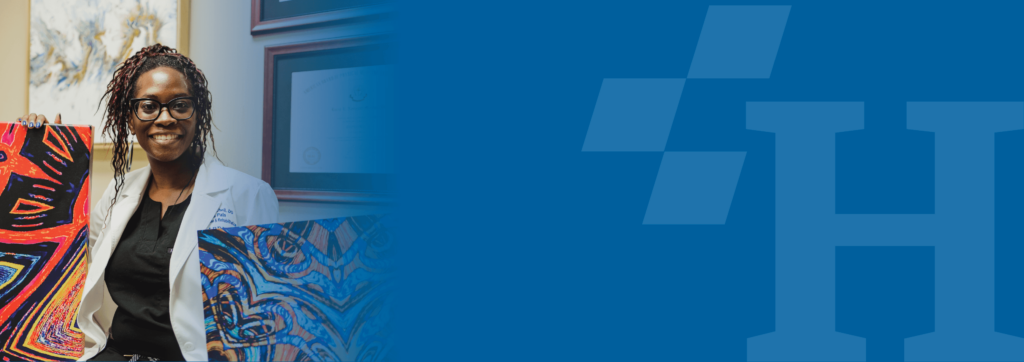The Art of Healing: Dr. Lucie Mitchell Blends Her Crafts

Stepping into Dr. Lucie Mitchell’s practice at Harbin Clinic Spine and Pain Management Rome, new patients experience a clean, comfortable space, but there’s something unusual too. Inspired by her encounters with abstract art, the walls of Dr. Mitchell’s exam rooms display large-scale artwork of her design. Beginning with images of her spine, Dr. Mitchell uses an array of digital software to manipulate the images into beautiful and unrecognizable abstract compositions. When asked about her passion for both art and medicine, she describes the two as deeply connected: “Medicine is an art,” she reflects, “but also art is a form of healing.”

Dr. Mitchell loved art as a child, and she returned to painting and photography while in her fellowship during the height of the COVID pandemic. Creating beauty is an escape and an outlet from her routine. She creates first for herself, focusing on parts of the body, like the spine, and then also studies everyday beauty that makes her stop and take in the world.
In her other craft, physiatry, she also views her patients as layered, complex stories: “I see the whole person in front of me, but I also see them in layers,” she says. “I remove layers, starting with the skin, the muscles, and I just see a skeleton. Then, when they describe where their pain is, I put the layers back on until I find the issue.”
Dr. Mitchell works in abstract art because she believes it has the power to tell different stories. “Our humanity and stories determine how we experience artwork,” she explains, describing how artists and viewers come away with different perspectives from abstract pieces.
Dr. Mitchell believes the environment of care can have an important impact on the patient and physician connection. Describing how some medical spaces feel dull or without hope, Dr. Mitchell wants her spaces instead to feel inviting, comfortable, and colorful:
“When patients are waiting, I want to stimulate their brains and get their minds off whatever they are here for, their pain, for example. Art can put someone in a different space. My hope is that the artwork also lets patients know not to be afraid of my doctor persona. We can both be ourselves here.”
Dr. Mitchell is not shy to discuss all that she has overcome. She named her collection of artwork, “Phoenix Noir Designs” as a reflection on her life experience and cultural identity. Growing up in Canada and moving to the US at age 8, she was required to rapidly learn English, her third language, to survive elementary school. Later, she gave birth to one child during graduate school and another during medical school. Her difficult second labor her but gave her a new perspective on her patients’ medical experiences and embedded a strong sense of empathy in her medical practice.

Still, Dr. Mitchell reminds her patients that pain is part of being human: “We all have pain in our lives, and we are not meant to live completely pain-free. Our pain often acts as an important signal to stop or rest.”
In some ways, Dr. Mitchell’s artwork is born out of rest. After Dr. Mitchell has a long day, her artistic process is her reset. During her medical fellowship, lead physicians frequently addressed physician self-care due to the potential dangers of physicians overworking.
“Art is the way I care for myself, and I know if I’m not well, then I can’t take care of others,” says Dr. Mitchell.
Dr. Mitchell’s story is a reminder that we all add unique beauty to our communities, and, behind the white coats and masks, Harbin Clinic physicians are regular people doing the hard work of caring completely for people.
To see Dr. Mitchell’s work, visit her website at https://www.phoenixnoirdesigns.com/ and to learn more about her practice, Harbin Clinic Spine and Pain Management Rome, visit https://harbinclinic.com/location/spine-pain-management-rome/.


